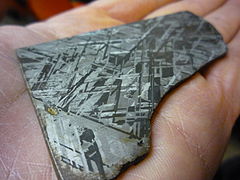Meteoric iron
| Meteoric Iron (native iron) | |
|---|---|

Widmanstätten pattern showing the two forms of nickel–iron minerals, kamacite and taenite, made visible by etching
|
|
| General | |
| Category | Native element mineral |
|
Formula (repeating unit) |
Fe and Ni in different ratios |
| Space group | Different structures |
| Identification | |
| Luster | Metallic |
| Diaphaneity | Opaque |
Meteoric iron, sometimes meteoritic iron, is a native metal found in meteorites and made from the elements iron and nickel mainly in the form of the mineral phases kamacite and taenite. Meteoric iron makes up the bulk of iron meteorites but is also found in other meteorites. Apart from minor amounts of telluric iron, meteoric iron is the only naturally occurring native metal of the element iron on the Earth's surface.
The bulk of meteoric iron consists of taenite and kamacite. Taenite is a face centered cubic and kamacite a body centered cubic iron-nickel-alloy.
Meteoric iron can be distinguished from telluric iron by its microstructure and perhaps by its chemical composition also, since meteoritic iron contains more nickel and less carbon.
Trace amounts of gallium and germanium in meteoric iron can be used to distinguish different meteorite types. The meteoric iron in stony iron meteorites is identical to the "gallium-germanium group" of the iron meteorites.
Meteoric iron forms a few different structures that can be seen by etching or in thin sections of meteorites. The Widmanstätten pattern forms when meteoric iron cools and kamacite is exsolved from taenite in the form of lamellas.Plessite is a more fine-grained intergrowth of the two minerals in between the lamella of the Widmanstätten pattern.Neumann lines are fine lines running through kamacite crystals that form through impact-related deformation.
...
Wikipedia
